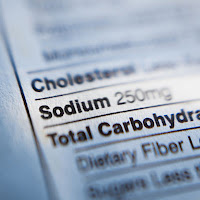Blood pressure is the force of blood pushing against blood vessel walls. The heart pumps blood into arteries to be carried throughout the body.
What is HIGH blood pressure?
Also known as hypertension, this is the condition in which the pressure in your arteries is above normal range. Having high blood pressure leaves athletes susceptible to problems such as arteriosclerosis, atherosclerosis, and aneurysm. Athletes especially would be at risk for these problems due to the natural increase in blood pressure with physical activity.
Blood pressure and nutrition...
Certain foods and/or gaining weight can increase blood pressure. Also, losing weight can reduce blood pressure. Sodium is a mineral that occurs naturally in foods. Salt and MSG (monosodium glutamate - commonly found in Chinese food) are two ingredients used to add sodium to foods, as they are mostly made up of sodium. The American Heart Association recommends that a person consume less than 2,300 mg of sodium per day. To put it in perspective, one teaspoon (tsp) of salt has about 2,400 mg of sodium in it. As we know, the average person greatly exceeds these guidelines the AHA puts out. The problem is that when a person takes in too much salt, their bodies retain extra water to "wash" it away. In some people, this causes a rise in blood pressure and puts added stress on the heart and vessels.
What should I eat to control my BP?
- Eat foods lower in salt, fat, and calories
- Use salt substitutes and sodium free spices and herbs to flavor foods
- Use less butter, margarine, shortening, and salad dressings
What should I NOT eat to control my BP?
- Processed foods such as lunch meats, sausage, bacon, and ham
- Avoid table salt
- Canned soups, bouillon, and dried soup mixes
- Use condiments sparingly (such as Ketchup, Soy Sauce, salad dressing)
- Frozen and boxed mixes for potatoes, rice, and pasta
- Avoid snack foods such as pretzels, popcorn, peanuts, and chips that are high in sodium
- Avoid pickled or marinated foods
- Read nutrition labels and choose foods and drinks lower in sodium
- Choose foods marked "sodium-free", "low sodium" or "unsalted"
- Read content labels. They are listed in order of greatest amount first.
- Avoid alcohol
- Avoid all tobacco products, including dip
- Eat a variety of foods
- Eat foods high in dietary fiber (whole grain breads, cereals, pasta, fresh fruit, and veggies)
- Manage stress levels
Fast Food Examples
- McDonald's: Quarter Pounder with Cheese and Medium French Fries = 1,460mg
- McDonald's: Hamburger and small French Fries = 680mg
- Subway: Italian BMT = 1,870mg
- Subway: Oven Roasted Chicken Breast = 880mg
- Wendy's: Spicy Chicken Sandwich and Small Chili = 2,030mg
- Wendy's: Grilled Chicken Sandwich and Sour Cream and Chive Baked Potato = 1,000mg
- Qdoba: Steak Quesadilla = >2,000mg
- Qdoba: Chicken Tacos (3) = 1,410mg


